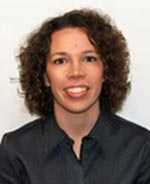New Members Join Aerosol Group
Published: 20 February 2017
Science and Operations Both Change Representatives

New members have been added to a constituent group that is working to help ensure the ARM Climate Research Facility’s aerosol measurements align with what scientists need to improve the understanding and modeling of how aerosol and trace gases impact climate processes.
Mike Ritsche and Gannet Hallar are replacing, respectively, Matt Gibson and Laura Riihimaki as members of ARM’s Aerosol Measurement Science Group (AMSG). Ritsche will represent the Southern Great Plains (SGP) atmospheric observatory and Haller will represent aerosol science.
Ritsche, Argonne National Laboratory, is ARM’s Assistant Southern Great Plains (SGP) Facility Manager. He brings deep operational expertise in field deployment of instrumentation in all climates and conditions to the AMSG.

Hallar, an Assistant Research Professor at the Desert Research Institute, is Director of the Storm Peak Laboratory in Steamboat Springs, Colorado. She is also an Associate Professor at the University of Utah’s Atmospheric Science Department. She provides scientific expertise in high-quality measurement of aerosols and trace gases. Together, Hallar and Ritsche make a strong addition to this important team.
Meanwhile, Matt Gibson has left the SGP operations team and has been replaced by Ken Teske, who will keep the megasite’s instrumentation humming. Laura Riihimaki, an atmospheric scientist at Pacific Northwest National Laboratory, takes up a new role as lead for ARM’s data translator team, managing the development of value-added products that make the terabytes of data collected by ARM’s instruments more useful to the scientific community. Both Gibson and Riihimaki rendered exceptional service while members of the AMSG.
The AMSG is an example of ARM leadership’s commitment to listening to its user base and aligning its capabilities accordingly. The constituent group was chartered in 2015 to work with the ARM Facility and Atmospheric System Research (ASR) user communities to identify measurement parameters and architecture required at ARM facilities to meet aerosol science needs. AMSG strives to improve knowledge of aerosol and trace gas impacts on climate processes affecting model simulations and forecasts.
The AMSG reports directly to Jim Mather, ARM Facility Technical Director. It also interacts with the User Executive Committee and the Science and Infrastructure Steering Committee. The group meets once or twice a year in person (usually at regular ARM and ASR events) and approximately by teleconference. Members serve for three years, but can extend their terms, if approved.
Rather than setting scientific priorities or objectives in aerosol research, the AMSG turns that top-down approach on its head, instead providing expert advice on measurements and processes required to best meet the aerosol science objectives of ARM and ASR. Again, it’s user driven, which has proven throughout ARM’s history to be the best way to maximize efficient use of resources and stay at the cutting edge of atmospheric science. Towards that end, we wish Hallar and Ritsche all the best in their new roles!
Other AMSG members include:
Allison McComiskey, Co-Chair and Science Co-Chair
Doug Sisterson, Co-Chair and ARM Instrument Coordinator
Allison Aiken, ARM Mobile Facility Site Operations Representative
Jerome Fast, General Science Representative
Connor Flynn, ARM Aerosol Data Translator
Steven Ghan, General Science Representative
Fred Helsel, North Slope of Alaska Site Operations Representative
Josh King, Data Quality Office Representative
Chongai Kuong, General Science Representative
Arthur Sedlacek, General Science Representative
Stephen Springston, ARM Aerosol Observing System Mentor.
# # #
The ARM Climate Research Facility is a national scientific user facility funded through the U.S. Department of Energy’s Office of Science. The ARM Facility is operated by nine Department of Energy national laboratories.
The ARM Climate Research Facility is a DOE Office of Science user facility. The ARM Facility is operated by nine DOE national laboratories, including .
Keep up with the Atmospheric Observer
Updates on ARM news, events, and opportunities delivered to your inbox
ARM User Profile
ARM welcomes users from all institutions and nations. A free ARM user account is needed to access ARM data.


















